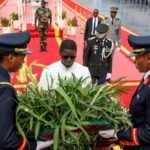Introduction to the Senegambian Region
The Senegambian region, encompassing the countries of Senegal and The Gambia, occupies a unique geographical position on the western coast of Africa. This area is bordered by the Atlantic Ocean to the west, providing it with breathtaking coastlines and a series of beautiful beaches, which contribute significantly to its tourism appeal. The region is characterized by its diverse topography, including wetlands, savannas, and forested areas, making it a haven for biodiversity and a prime destination for eco-tourism enthusiasts.
Culturally, the Senegambian region is rich and dynamic, showcasing a blend of ethnic groups, languages, and traditions. Senegal is known for its vibrant cultural scene, marked by music, art, and dance, reflecting both historical influences and contemporary expressions. Meanwhile, The Gambia offers a unique fusion of cultures, with a strong emphasis on communal living and traditional practices. This diverse cultural tapestry not only enhances the travel experience but also attracts visitors eager to explore the rich heritage of both nations.
The historical significance of the Senegambian region cannot be overstated. It has been a vital hub for trade and cultural exchange since ancient times, playing a crucial role in the transatlantic slave trade and serving as a meeting point for various peoples and cultures. Today, this history enriches the travel and tourism experiences available to visitors, who can explore historical sites, museums, and monuments that tell the stories of the region’s past.
In light of its geographical advantages, cultural diversity, and historical importance, the tourism potentials of the Senegambian region of West Africa are immense. This area not only offers an attractive destination for travelers seeking sun, sand, and cultural immersion but also harbors opportunities for sustainable and responsible tourism development. By understanding these distinctive attributes, one can appreciate why the Senegambian region is poised for significant growth in the travel and tourism sector.
Cultural Tourism Opportunities

The cultural tourism in the Senegambian region of West Africa is thriving, offering visitors an immersive experience into the rich traditions and vibrant lifestyles of its people. Senegal, a key player within this region, boasts a variety of cultural experiences that reflect its diverse heritage. From local traditions to artistic expressions, the cultural landscape provides a myriad of opportunities for exploration and appreciation.
One of the most notable aspects of cultural tourism in this area is the celebration of festivals, which play a significant role in preserving and showcasing local culture. Events such as the Dakar Biennale, a contemporary art festival, and the vibrant Tabaski Festival highlight the region’s artistic talents and traditional practices. These events not only attract international attention but also encourage local participation, strengthening community bonds and reinforcing cultural identity.
Additionally, the music and dance of Senegal are integral parts of its cultural tapestry. The rhythms of mbalax, a popular music genre, and traditional dances such as sabar offer visitors opportunities to engage with local artists and learn about the significance of these art forms in communal life. The harmony of sounds and movements tells stories of the past while fostering a sense of belonging among participants.
Historical and cultural heritage sites, such as Gorée Island—a UNESCO World Heritage site—are paramount to understanding the region’s history of the transatlantic slave trade and its influence on contemporary society. Such sites serve as poignant reminders of the past while facilitating discussions and reflections on identity and resilience.
Furthermore, the vibrant markets of Dakar, such as Sandaga and Kermel, illustrate the dynamic cultural exchanges through the selling of crafts, textiles, and local cuisine. These markets not only support local economies but also promote social interaction among visitors and residents, enhancing cultural appreciation.
In conclusion, the cultural tourism potentials of the Senegambian region of West Africa, particularly in Senegal, are significant. By embracing and promoting its cultural offerings, the region can continue to engage both locals and travelers, fostering a deeper understanding and respect for its diverse heritage and traditions.
Natural Attractions and Adventure Tourism
The Senegambian region of West Africa boasts an array of natural attractions that underpin its significant role in travel and tourism. This area, characterized by its diverse ecosystems and stunning landscapes, is a treasure trove for eco-conscious travelers and adventure seekers alike. National parks and wildlife reserves in Senegal serve as bastions of biodiversity, providing a habitat for various species, some of which are endemic to the region.
One of the most notable destinations is Niokolo-Koba National Park, a UNESCO World Heritage site, which is renowned for its rich wildlife and captivating landscapes. Here, visitors can engage in exciting safari tours, offering the chance to observe elephants, lions, and countless bird species in their natural habitats. Birdwatching, in particular, is a major draw for tourists, with the vibrant avifauna attracting ornithologists and casual bird-lovers to the area.
Additionally, the Atlantic coastline presents breathtaking beaches ideal for a range of coastal activities. Surfing along the waves of the Senegalese coast or fishing in its abundant waters offers thrill-seekers unique experiences that are intricately tied to the region’s tourism potentials. Furthermore, the mangrove ecosystems along the coast not only enhance the scenic beauty but also play a vital role in sustaining local biodiversity. Eco-tourism initiatives focused on these areas aim to promote sustainable travel practices while preserving the natural environment.
Efforts to protect these precious landscapes involve local communities, governments, and conservation organizations working together to ensure that the natural attractions of the Senegambian region remain robust and accessible for future generations. The balance between tourism and conservation is essential, as the region continues to develop its identity in the broad sphere of travel and tourism within West Africa.
Challenges and Future Prospects for Tourism Development
The development of travel and tourism in the Senegambian region of West Africa faces several challenges that require concerted efforts from various stakeholders. One of the primary hurdles is inadequate infrastructure, which can hinder accessibility to key tourist sites. Poor road conditions, limited public transport options, and underdeveloped amenities pose significant obstacles for potential travelers seeking to explore Senegal and its surrounding areas. Enhancing infrastructure is vital to not only attracting tourists but also ensuring their safety and comfort throughout their visit.
Political stability is another critical factor impacting tourism potentials in the Senegambian region. Fluctuations in governance and public policy can create uncertainty for investors and travelers alike. The region must foster an atmosphere of political assurance to bolster confidence among potential tourists and stakeholders in the travel and tourism sector. Encouraging transparency and dialogue among the government, non-governmental organizations, and local communities is key to navigating these political challenges.
Environmental concerns also play a pivotal role in the sustainable development of tourism. The region’s natural resources and biodiversity are increasingly at risk due to factors such as climate change and unsustainable practices. Implementing responsible tourism practices will not only protect these vital ecosystems but also add to the unique allure of Senegambia as a travel destination.
Addressing these challenges will require collaboration and strategic planning. The role of government, NGOs, and local communities is essential in creating a cohesive approach to tourism development. Investment opportunities can arise from forming partnerships that prioritize sustainability, enhance infrastructure, and fortify political landscapes. By focusing on these areas, the tourism potentials of the Senegambian region of West Africa can be unlocked, creating a dynamic and thriving travel environment.











More Stories
Op-Ed: Before it was Memorial Day
Mayor Adams’ Community Op-Ed: Our Bodegas Were a Lifeline During COVID-19. Now, We Are Providing a Lifeline to Them
Community Op-Ed: Destroying Guns, Protecting Our City